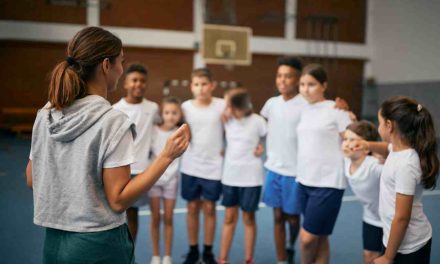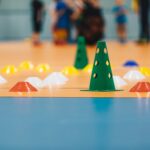Assessment In PE
Assessment measures the breadth and depth of learning which has taken place. Used correctly, assessment can inspire, motivate and provide feedback essential for targeting corrective help to pupils.
Assessment helps maps a pupil’s progress through the Key Stages. Effective assessment is dependent upon the development of a number of teaching skills as well as having a sound and efficient assessment policy in place.
Methods of assessment vary between individual teachers, departments, and schools as a whole. Whether it is planned for or not, assessment occurs on a daily basis.
Assessment of pupil progress in physical education is directly related to the subject’s curricular aims, and is designed to complement and supplement the National Curriculum level descriptions.
To this end, pupil attainment and progress are assessed in respect of their ability to ‘develop skills’; ‘make and apply decisions’; ‘develop physical and mental capacity’; ‘evaluate and improve performance’; and ‘make informed choices about healthy and active lifestyles’.
The diversity of the criteria applied acknowledges the differing areas of competency associated with being physically educated, and seeks to give due recognition to each pupil’s progress and attainment within each.
With this in mind, the Physical Education assessment process is an integral part of teaching and learning. Assessment criteria are directly linked to learning objectives, and teachers’ continuous, formative assessments enable them to judge pupils’ progress towards the relevant learning objectives over the long, medium and short term. This takes time.
Primary To Secondary
When students arrive from primary education, they also take time. Time to settle, time to learn the expectations, time for the teacher to learn names, time to feel comfortable and confident in a new environment with different people. It can take weeks, maybe months for some students to express themselves as they normally would in PE.
By throwing students into the secondary school process with no prior information for teachers to plan their lessons on is a waste of time on everyone’s part. Yes, there is obviously going to be transition time. Yet with no knowledge of the students, this time is only holding back the development process of the student.
With no indication of the levels of ability from primary to secondary how can teachers plan, organise and evaluate the content and pace of their lessons, as well as the appropriateness of the tasks and resources selected?
Baseline Assessment
Physical Education has many processes by which to assess young people. By having prior knowledge of those students from primary to secondary age their transition phase can be made much easier. The following points emphasise how:
Records of assessments inform teachers’ planning; facilitate ease of communication between teachers, teachers and pupils, and provide information for reporting to parents and others.
Baseline assessment criteria can describe positive achievements, recognise different levels and identify future learning targets. It can provide support for teachers by identifying appropriate and progressive learning objectives to meet the individual and corporate needs of pupils.
- It informs parents, teachers, employers, and not least the pupils themselves of a level of performance and learning.
- Information of students’ progress and attainment can be established, their personal qualities and attributes, and acknowledgement made of any elements of gifted and talented performance.
- It motivates. Providing pupils with recognition of how well they’ve achieved, only spurs them on to get better and aim higher.
- It monitors learning over time. For instance, how far an individual has developed and provides a point from which to begin.
- It enables pupils to progress. Without knowledge of where they’re at, how can they improve?
Baseline Assessment Strategies
Baseline assessment should be an integral part of the learning process.
Teachers need this information to be able to make informed judgements about the content, depth, breadth and appropriateness of their future lessons.
Baseline assessments have been conducted in order to provide teachers with a starting point.
Always remember that:
- Methods of assessment should vary depending on the skills, understanding or attitudes involved
- A variety of assessment techniques should be used appropriate to the pupil and subject matter
- Learning objectives should be shared with pupils so that they know what is being assessed
- Pupils should be involved in the process of self assessment and target setting
- A range of achievements should be assessed
- There must be regular feedback in order to motivate, to generate confidence, and inform pupils’ about their achievements
- It is essential assessment systems are consistent within individual departments
Some schools will choose to maintain mixed ability groupings and use the baseline data to differentiate within. Others will differentiate groups in order to base activities and tasks according to the baseline data.
There are valid reasons for both methods.
Where abilities are wide ranging or where behavioural problems exist within schools, differentiating PE groups from baseline data has been found to reduce behaviour problems; allow for fairer competition within groups; successfully challenge those of a higher ability; enhance safety and reduce the risk of accidents; enable LSAs to work closely in groups where pupils have learning difficulties.
How Do We Assess?
Baseline assessment can take a variety of forms including;
- Teacher observations
- Pupil self assessment
- Filmed performance
- Photographic evidence
- Activity logs
- Extra curricular activities
- Test results
What is important is that whichever method is used, it must be standardised by the ‘assessors’ and be of relevance to the key processes on which the National Curriculum for P.E is based.
Personal Baseline assessment
How we baseline in my establishment is different too. We do this by going into our primary schools twice a year for year 5’s and 6’s and do some simple testing around special awareness, hand and eye co-ordination, striking a ball with feet and hands, SAQ ladder work, hurdle work and some dance.
Alongside this every test includes Mathematical, Science and English concepts so that every child sees PE in a different light.
As members of staff we use year 12 students to help the students along with the tests and we simply mark 1,2,3 down for each performance with scores. We also mark each student for behaviour, attention and scores.
This is then correlated alongside the students Maths and English scores to create our sets on ability within our year 7 sessions. We can then staff the right support with those different groups and subsequently differentiate our groups so the levels are right. Throughout the year we also baseline test students to track their progress (again including Maths and English).
Summary
Baseline assessment in Physical Education allows a starting point to work from and to continue and re-evaluate over an activity, a term, a year or a key stage. This could be referred to by the following year’s teacher to identify an individual’s strengths and weaknesses, thus helping to set realistic learning objectives for all teachers.
By assessing pupils using a baseline method, they can be given the recognition for what they are doing well, be told where improvements can be made and given advice on and how to improve. Implementing assessment criteria in a number of different areas can go a long way towards an individual’s development and aspirations.
Sam Clark is a senior PE Teacher at Balby Carr Community Sports College in Yorkshire









